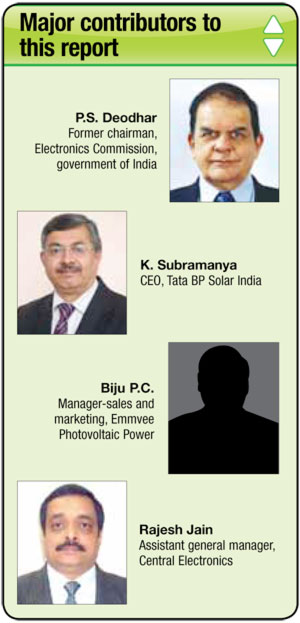Metering arrangements. Metering arrangements should be made by the project proponents in consultation with the distribution utility keeping in view the guidelines or regulations notified by the respective state electricity regulatory commissions, if any. Meters should comply with the requirements of CEA regulations on the meter installation and operation.
Financial criteria. The project proponents should submit their letters of commitment along with board resolution for equity investments in the project, calculated on the basis of Rs 40 million per megawatt on a pro-rata basis.
Infrastructure criteria for land requirement. The project proponents should make arrangements for land required for the project as per conditions outlined by respective state competent authority.
Infrastructure criteria for grid connectivity requirement. The plant should be designed for interconnection with the grid at the distribution network at the voltage level depending on the installed capacity of the rooftop PV or small solar system generator.
(For the complete requirement list please visit www.mnre.gov.in)
[/stextbox]The government is also encouraging the use of rooftop power plants as a substitute for diesel-consuming and polluting DG sets. Most commercial buildings are dependent on diesel generators during power cuts. Investing in a rooftop solar power plant can offset diesel consumption and make the returns attractive. Added to this, the 30 per cent central finance assistance (CFA) in the form of capital subsidy would encourage investors. With a rooftop installation, one can recover the project’s cost within five t six years. Also, typically, a solar power plant has a life of 25 years with proper maintenance.
The return on investment (ROI) completely depends on the power purchase agreement signed by the project developer. While earlier the buying rate for power was Rs 17 per unit, today companies are ready to sell it at Rs 11 per unit, making only a marginal profit.Considering the current trend, the power purchase price can be estimated at Rs 13-14, so one can expect ROI within six to seven years.
More benefits for commercial units
Rooftop installation makes more sense for commercial establishments as these can utilise the solar power during peak-load daytime periods, thus saving the money required to set up battery banks. Any amount of power not used can be stored in a battery bank for use at night when energy consumption is the least (about 10 per cent compared to the day).

Moreover, for small business establishments or small and medium enterprises (SMEs), a rooftop installation for grid connection is far more profitable than a multi-megawatt plant which requires installation of six to eight transformers. Transformers are at most 98 per cent efficient and therefor while generating solar power, some energy is lost due to the ineffciency of these transformers. So it is profitable to install smaller power plants with 100 per cent of electricity production, which can then be transferred to the local utility.
Government’s role in encouraging small producers
Change in government policies will help rapid growth of the solar power sector in our country via rooftop and other low-power solar plants. MNRE should quickly clarify when the power utilities will be instructed to buy solar power from 5kW-100kW solar plants at the same rate as +1MW plants. As more and more rooftop solar power plants feed power into the grid, local power utility companies should be happy to buy power at a higher price as this will help them earn carbon credits.
MNRE needs to remove all the remaining roadblocks to encourage rooftop and backyard solar power plants of 5 kW to 500 kW capacity to feed their solar power into the grid and augment shortage of supply from utility companies. Every other country in the world pays a high rate for such solar power fed into the grid and this makes such an investment very rewarding. The available metering technology is secure enough for the government to not worry about misuse.
Government subsidies
Government subsidies for standalone rooftop PV installations vary from state to state. For standalone use, today, there is a system that comes with a 40-watt solar panel, 40V battery and two LED bulbs for around Rs 8000, to which the government provides close to a 50 per cent subsidy. By installing this solar system, monthly electricity bills fall by about Rs 60 a month (calculated at the rate of Rs 2 per unit). Conventional electricity bills are currently about Rs 6-7 per unit for residential purposes and Rs 10-12 per unit for commercial establishments.
The government is yet to announce the final specifications and subsidies (or incentives) for rooftop installations that feed into the grid.
Some challenges
The major challenge faced by the project developers is to realise the benefts of the policy. Not only do the specifications vary from state to state but also the buying rates. Some companies are buying power at as low as Rs 11 per unit, thus discouraging players from venturing into this segment as they make only a marginal profit.
Another challenge is that some unscrupulous players, instead of injecting solar power from their panels, may connect the mains power (conventional electricity) from their neighbour’s building to the grid. In such a scenario it becomes difficult for the energy meter to detect the mode of power. However, this challenge is being overcome by introducing innovative DC energy meters that detect the kind of power being transmitted and accept only the power generated by solar PV panels. While this concept is yet to take off in India, there are some specifications laid down y the government with regard to metering.
The author is an assistant editor at EFY






